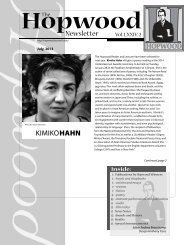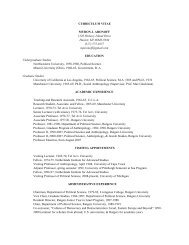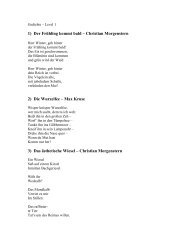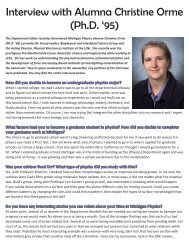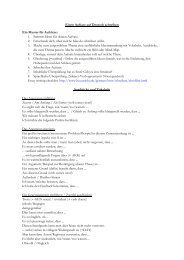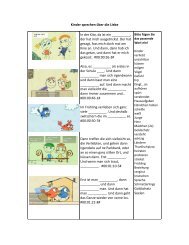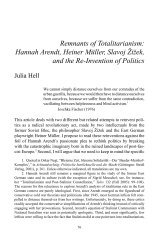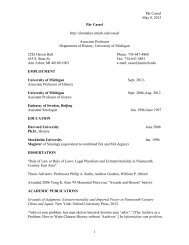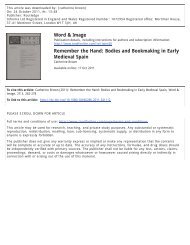(KCJS) In - University of Michigan
(KCJS) In - University of Michigan
(KCJS) In - University of Michigan
You also want an ePaper? Increase the reach of your titles
YUMPU automatically turns print PDFs into web optimized ePapers that Google loves.
CGIS: Kyoto Consortium for<br />
Japanese Studies (<strong>KCJS</strong>) in Kyoto,<br />
Japan<br />
Student Handbook Supplement<br />
Academic Year 2011-2012<br />
<strong>University</strong> <strong>of</strong> <strong>Michigan</strong><br />
Center for Global and <strong>In</strong>tercultural Study
TABLE OF CONTENTS:<br />
PROGRAM OVERVIEW .............................................................................................................................. 1<br />
Calendar ................................................................................................................................................... 1<br />
Academic Arrangements .......................................................................................................................... 1<br />
PROGRAM INFORMATION ........................................................................................................................ 2<br />
Who Takes Care <strong>of</strong> What? ....................................................................................................................... 2<br />
Housing .................................................................................................................................................... 2<br />
FEES AND BILLING ................................................................................................................................... 3<br />
BEFORE YOU GO: TRAVEL, MONEY, AND VISAS ................................................................................. 3<br />
Travel ....................................................................................................................................................... 3<br />
Money ....................................................................................................................................................... 3<br />
Accessing Funds in Japan .................................................................................................................... 3<br />
Paying for Things in Japan ................................................................................................................... 4<br />
Visas ......................................................................................................................................................... 4<br />
WHILE THERE: ETIQUETTE, INSURANCE, AND SAFETY ...................................................................... 5<br />
Etiquette / <strong>In</strong>vitations ................................................................................................................................ 5<br />
Names ...................................................................................................................................................... 5<br />
Social Drinking ......................................................................................................................................... 5<br />
The Gaijin Syndrome ................................................................................................................................ 5<br />
General Politeness ................................................................................................................................... 6<br />
MEDICAL COVERAGE FOR UNIVERSITY OF MICHIGAN STUDENTS .................................................. 7<br />
<strong>In</strong>surance .................................................................................................................................................. 7<br />
Japanese National Health <strong>In</strong>surance........................................................................................................ 7<br />
Safety ....................................................................................................................................................... 7<br />
NATURAL DISASTERS... ........................................................................................................................... 7<br />
Earthquakes (jishin) .................................................................................................................................. 7<br />
Typhoons (taifu) ....................................................................................................................................... 8<br />
IF YOU GET LOST… .................................................................................................................................. 8<br />
CONTACT INFORMATION ......................................................................................................................... 9
Congratulations on your participation in the <strong>University</strong> <strong>of</strong> <strong>Michigan</strong>’s program at the Kyoto Consortium for<br />
Japanese Studies (<strong>KCJS</strong>). The information in these pages, explains how the program will work for you as<br />
a U-M student and should be read in conjunction with the handbook and other materials you receive from<br />
<strong>KCJS</strong>. Please take this information with you when you go abroad, along with the CGIS General<br />
Handbook.<br />
PROGRAM OVERVIEW<br />
As a U-M student at <strong>KCJS</strong>, you will be enrolled in a program shared by a consortium <strong>of</strong> American<br />
universities with strong interests in Japanese studies and Japanese language instruction. You will be<br />
subject to the same academic requirements as other <strong>KCJS</strong> students, taking courses with them and<br />
assessed according to the same standards. Course enrollments will happen on-site, during the<br />
orientation. Students on the <strong>KCJS</strong> program will earn 16 credits per term, 8 <strong>of</strong> which are for the Japanese<br />
language class. <strong>In</strong> addition to the Japanese language class, students also choose 2 courses taught in<br />
English from the list <strong>of</strong> program classes. (You can find more information on this on <strong>KCJS</strong>’s website.)<br />
An integral component <strong>of</strong> the Japanese language program is the Community <strong>In</strong>volvement Project<br />
(CIP) which is designed to support Japanese language learning through integration with the local<br />
community. All students pursue a personal interest by participating in volunteer work, joining an activity<br />
circle, or privately studying a Japanese art with a mentor. The CIP provides a framework for students to<br />
become involved in these activities by focusing on how to build networking skills and how to manage<br />
cross-cultural encounters, and through group sessions, reports, and presentations, encouraging students<br />
to reflect on these experiences.<br />
At the same time that you are attending <strong>KCJS</strong>, you will be registered at U-M and thus will earn inresidence<br />
credit for your work at <strong>KCJS</strong> (see below under Academic Arrangements). Any financial aid you<br />
receive from U-M may be applied toward the costs <strong>of</strong> the program, as can most U-M-awarded<br />
scholarships.<br />
Columbia <strong>University</strong>’s Office <strong>of</strong> Continuing Education handles administration <strong>of</strong> the program, coordinates<br />
appointment <strong>of</strong> the program director, and maintains the program center, centrally located in Kyoto and<br />
(as <strong>of</strong> Fall term 2009) on the Doshisha <strong>University</strong> campus, allowing <strong>KCJS</strong> participants the opportunity to<br />
meet Japanese university students.<br />
CALENDAR<br />
You can find the <strong>KCJS</strong> academic calendar on their website:<br />
http://www.ogp.columbia.edu/index.cfm?FuseAction=Abroad.ViewLink&Parent_ID=2EE21ECC-BCDE-<br />
E7F3-5C38793579099621&Link_ID=2EE6CC7D-BCDE-E7F3-<br />
5145D3525146DA3E&Program_ID=10320&Type=O and find it in the <strong>KCJS</strong> student handbook.<br />
You should plan on arriving in time to attend the orientation and to remain through the last day <strong>of</strong> exams.<br />
U-M students may not arrive late or depart early.<br />
Fall Semester 2011: September 1, 2011 – December 13, 2011<br />
Winter Semester 2012: January 6, 2012 – April 25, 2012<br />
ACADEMIC ARRANGEMENTS<br />
As a U-M student participating in a CGIS program, you will be enrolled at U-M at the same time you are<br />
taking classes at <strong>KCJS</strong>. You will need to register for the program before you leave Ann Arbor. Fall<br />
semester and Winter semester students should register for 12 credits <strong>of</strong> the STDABRD placeholder<br />
course; please refer to the CGIS General Handbook (p39) for the correct course number. Academic Year<br />
students should register for 12 credits <strong>of</strong> STDABRD in Fall semester, and will need to register again for<br />
The <strong>University</strong> <strong>of</strong> <strong>Michigan</strong>: Center for Global and <strong>In</strong>tercultural Study<br />
1
12 credits <strong>of</strong> STDABRD in Winter semester. This is the only course you will be registered for while away,<br />
and it serves as a “place holder,” maintaining your status as a fully-enrolled student at U-M.<br />
When you arrive at <strong>KCJS</strong>, you will choose your classes, but in preparation for that, <strong>KCJS</strong> (and CGIS)<br />
expects that prior to traveling to Japan, you have met with a U-M concentration and/or general advisor to<br />
discuss the courses you plan to take and how they may count toward your degree. <strong>In</strong>formation about<br />
<strong>KCJS</strong> classes can be found on their website. During the orientation at <strong>KCJS</strong>, you will draw up your plan<br />
<strong>of</strong> study, and if, for some reason, your final choices differ from what you had originally discussed with<br />
your U-M advisor, contact the U-M advisor and review with him/her your new selections. (It is useful to cc<br />
CGIS on these e-mail messages, as it will then become part <strong>of</strong> your CGIS file and can be referred to<br />
when you return.)<br />
U-M requires all CGIS students to be enrolled for a full load <strong>of</strong> classes at their host universities. At <strong>KCJS</strong>,<br />
courses consist <strong>of</strong> intensive language courses, plus content courses <strong>of</strong>fered by Japanese and visiting<br />
American faculty. If you wish to add or drop courses, you will be subject to <strong>KCJS</strong>’s deadlines. If you<br />
decide to drop a class, be sure you do not fall below the minimum full-time program requirements for<br />
both <strong>KCJS</strong> and U-M.<br />
CGIS students can take courses Pass/Fail during the program; please refer to the section on Pass/Fail in<br />
the General Handbook for details. If you plan to take a course or courses on a pass/fail basis, notify your<br />
CGIS Advisor and submit the Pass/Fail form via e-mail by the deadline:<br />
http://www.lsa.umich.edu/cgis/mgap/acceptance.html.<br />
Once you have completed your semester at <strong>KCJS</strong>, Columbia <strong>University</strong> will provide CGIS with a<br />
transcript and CGIS in turn will update your U-M academic record. The actual courses, credits, and<br />
grades will be part <strong>of</strong> your U-M record, with exact credits replacing the 12 “place-holder” credits you<br />
registered for before going abroad. Your grades will appear on your U-M transcript and will factor<br />
into your overall GPA. Students who plan to continue their study <strong>of</strong> Japanese language at U-M will be<br />
required to take a placement test, administered by the Department <strong>of</strong> Asian Languages and Cultures,<br />
once they return.<br />
**Special Note: if you enroll for more than the equivalent <strong>of</strong> 18 U-M credits while in Japan, you will be<br />
charged additional tuition back at U-M when the grades are posted to your account (extra tuition charges<br />
apply for courses taken in Japan just as in Ann Arbor).<br />
PROGRAM INFORMATION<br />
WHO TAKES CARE OF WHAT?<br />
<strong>KCJS</strong> is responsible for acceptance decisions, all academic arrangements, on-site orientation, and<br />
housing. CGIS assists students in preparing to study in Kyoto, provides support services while they are<br />
abroad, and processes the academic results from study at Kyoto for the students’ U-M academic<br />
records. Each student is responsible obtaining a passport and visa, for making the travel reservations,<br />
and for returning to <strong>KCJS</strong> travel information and other required forms. The <strong>KCJS</strong> student manual<br />
contains useful information about how to handle money while in Japan, what to pack (and what to leave<br />
at home), and what you can expect while studying at <strong>KCJS</strong> and living in Japan.<br />
HOUSING<br />
Housing will be arranged by <strong>KCJS</strong>. Most students will live with Japanese families, although a few may<br />
live in apartments leased by <strong>KCJS</strong>. Students who live in home stays will eat breakfast and dinner with<br />
their families (lunch is not provided but students will receive a lunch stipend from <strong>KCJS</strong> and buy lunch on<br />
their own). Students in apartments will also receive a lunch stipend from <strong>KCJS</strong>, and are responsible the<br />
cost <strong>of</strong> all other meals and snacks. Please see the <strong>KCJS</strong> website and materials for more details:<br />
http://www.ogp.columbia.edu/index.cfm?FuseAction=Abroad.ViewLink&Parent_ID=2EE21ECC-BCDE-<br />
The <strong>University</strong> <strong>of</strong> <strong>Michigan</strong>: Center for Global and <strong>In</strong>tercultural Study<br />
2
E7F3-5C38793579099621&Link_ID=2EE71093-BCDE-E7F3-<br />
50FE6C61BBF4F5CD&Program_ID=10320&Type=O<br />
FEES AND BILLING<br />
Although students are registered at U-M while participating in the program at <strong>KCJS</strong>, the program tuition,<br />
housing, and other fees are paid directly to <strong>KCJS</strong>. The only fee charged by U-M is CGIS administrative<br />
fee <strong>of</strong> $1200/semester or $1,600/year. <strong>KCJS</strong> provides students with information about program costs in<br />
its acceptance materials and on the website.<br />
BEFORE YOU GO: TRAVEL, MONEY, AND VISAS<br />
TRAVEL<br />
CGIS does not make travel arrangements. All students, except those who plan to travel in Asia before<br />
the start <strong>of</strong> the academic year, should avoid making firm reservations until you receive word from <strong>KCJS</strong><br />
about the academic schedule and mandatory arrival date. You must be sure to arrive in time to<br />
participate in the orientation program required by <strong>KCJS</strong>. Note that the housing may only be open on a<br />
certain day for you to move in- if you arrive prior be prepared to stay in a hotel until the housing is<br />
available.<br />
MONEY<br />
As participants in the <strong>KCJS</strong> program, you will pay fees for the program tuition, and you will be<br />
responsible for the costs <strong>of</strong> housing, food, local transportation, books, and all personal expenses while<br />
you are abroad. Please read carefully through the materials supplied by <strong>KCJS</strong> as well as the cost sheet<br />
provided by CGIS to calculate what expenses to expect and how best to handle your money.<br />
You probably will spend more overseas than in a comparable period at home because <strong>of</strong> unusual<br />
opportunities. Some students recommend that you bring a generous estimate <strong>of</strong> what you will need for<br />
your first two months (keeping a small amount on hand for emergencies) and record your expenses so<br />
you can get additional money sent to you based on a budget for the rest <strong>of</strong> the year. Students estimate<br />
that they spend at least ¥10,000- ¥15,000 per week on postage, snacks, meals, transportation, gifts,<br />
books and magazines, discos/bars, and field trips.<br />
It is wise to have some yen on arrival in Japan; take about $200-$300 (approximately ¥40,000- ¥50,000)<br />
to be able to handle a taxi, train ride or meal. You can easily change money at the airport, where rates<br />
are the same as banks. Most U.S. banks with international operations can special-order yen, although<br />
you may not receive as many yen when you exchange dollars in the U.S. as you will in Japan.<br />
ACCESSING FUNDS IN JAPAN<br />
Past students have found different ways to meet their financial needs in Japan.<br />
1) ATM Machine: One <strong>of</strong> the easier ways for you to access money will be for you to keep your USbased<br />
bank account and ATM card. You can use the ATM card in Japan, at machines and banks<br />
where the logos on the back <strong>of</strong> your card match the logos on the ATM machine (PLUS, CIRRUS,<br />
etc). Your family can deposit money for you in the US, and you can withdraw money (in yen) in<br />
Japan. There will be withdrawal fees associated with cash withdrawal, so you should investigate the<br />
best way to withdraw the most money with the least fees.<br />
Prior to departure, inquire with your bank or card companies in the U.S. to see if you can use your<br />
ATM card or debit card and personal identification number (PIN) from abroad to access funds in<br />
your U.S. account. <strong>In</strong> addition, find out if ATMs are accessible in the area where you will reside in<br />
Japan. The cash amount you will be able to withdraw from an ATM in Japan is limited to the amount<br />
The <strong>University</strong> <strong>of</strong> <strong>Michigan</strong>: Center for Global and <strong>In</strong>tercultural Study<br />
3
you can withdraw in America rounded down to the closest ¥10,000. Be careful: some students report<br />
that foreign cards can get stuck in ATMs.<br />
ATMs at 7-Eleven convenience stores across Japan accept many international debit or credit cards.<br />
According to 7-Eleven, most Plus and Cirrus cards should work, including Visa, MasterCard,<br />
Maestro, American Express, JCB, and UnionPay cards. The service charge differs depending on the<br />
card. This service is available in most regions <strong>of</strong> Japan, including most <strong>of</strong> Honshu, all <strong>of</strong> Hokkaido,<br />
and much <strong>of</strong> Kyushu.<br />
2) Post Office Savings Account: It is possible to open a savings account at a post <strong>of</strong>fice. With this type<br />
<strong>of</strong> account, you can withdraw money at post <strong>of</strong>fices throughout Japan for free. Major post <strong>of</strong>fices<br />
have facilities for exchanging cash and travelers checks. <strong>In</strong> addition, many post <strong>of</strong>fices have ATMs.<br />
These ATMs are usually open longer hours than the bank, and you can withdraw money from these<br />
ATMs during the weekends for free.<br />
3) Japanese Bank Account: Although it is recommended for convenience, you do not need to open a<br />
bank account in Japan, but some students feel this is a great way to handle money if you will be in<br />
Japan for a year program. You might also open an account at the U.S. branch <strong>of</strong> a large Japanese<br />
bank (Sumitomo, Sanwa, Tokyo-Mitsubishi, etc.) before you leave for Japan. (Be sure to leave your<br />
account number with your parents so they can make deposits for you if necessary.) Most banks are<br />
open weekdays (9 a.m. to 3 p.m.) and closed on weekends and national holidays. ATM hours are<br />
usually weekdays from 8:30 a.m. to 6 or 9 p.m., and there is an extra fee between 6 p.m. and 9 p.m.<br />
On weekends, ATMs may be used until 5 p.m. for a fee <strong>of</strong> U.S. $1 to $2 per transaction. Some<br />
convenience stores have ATMs connected to major banks. Verify this information with your bank<br />
when you open an account.<br />
PAYING FOR THINGS IN JAPAN<br />
1) Most purchases must be paid in cash, so don’t expect to charge most <strong>of</strong> what you buy. Most<br />
banks will not allow you to withdraw cash with a credit card, but there are ATMs in Kyoto where you<br />
can withdraw funds directly with debit cards that access the Plus, Cirrus, NYCE, and other global<br />
networks. Most people in Japan pay cash and feel safe carrying significant sums around with them.<br />
2) Debit Cards: Debit cards are not used in Japan to pay for things (but if your debit card is also a<br />
credit card, you should be fine). Credit cards such as JCB (Japan Credit Bureau), Visa, MasterCard,<br />
Diner’s Club, and Bank Americard are widely accepted (Visa is accepted more than MasterCard) at<br />
major restaurants, hotels, and in department stores.<br />
3) Traveler’s checks (some in yen and most in dollars) are convenient, can be replaced if lost or stolen,<br />
and can be exchanged at most bank branches or hotels (you may be asked to show your passport<br />
for identification). They are not <strong>of</strong>ten accepted at stores.<br />
4) Personal checks are not used in Japan. Personal checks or bank checks (drawn against either a<br />
dollar or a yen account) are difficult to cash at best, and the process takes five-to-six weeks. Where<br />
possible to cash, there will be a large handling fee per check. Japanese banks will not accept<br />
personal checks made out to students. You should ask at your bank at home, however, if special<br />
bank account arrangements are possible with cooperating banks in Japan.<br />
VISAS<br />
U.S. citizens must obtain a student visa in the U.S. prior to departure. (Non-U.S. citizens, please check<br />
with the Japan Embassy to determine if a study visa is required: Electronic Embassy . When researching<br />
the visa application process, pay close attention to requirements to exit the country and reenter the U.S.)<br />
The <strong>University</strong> <strong>of</strong> <strong>Michigan</strong>: Center for Global and <strong>In</strong>tercultural Study<br />
4
About two to four weeks prior to departure, you will receive the various documents (e.g., <strong>of</strong>ficial program<br />
admission letter, Certificate <strong>of</strong> Eligibility, verification <strong>of</strong> scholarship award, etc.) needed to apply for a<br />
student visa from the Japan Consulate nearest to your state <strong>of</strong> permanent residence (see website below<br />
for contact information). After receipt <strong>of</strong> this document, immediately apply for a student visa at the Japan<br />
consulate. You cannot apply for your student visa until you have received the Certificate <strong>of</strong> Eligibility from<br />
<strong>KCJS</strong>.<br />
<strong>KCJS</strong> provides instructions and recommendations for U.S. citizens in their pre-departure materials and<br />
program handbook.<br />
You are responsible for ensuring that your visa does not expire before you leave Japan. Per Japan<br />
government regulations, students who stay in Japan illegally, even one day past the visa expiration<br />
period, will be fined, sent to a detention center, expelled immediately, and banished from returning to<br />
Japan for five years.<br />
WHILE THERE: ETIQUETTE, INSURANCE, AND SAFETY<br />
ETIQUETTE / INVITATIONS<br />
When invited to someone's home, arrive on time, take an omiyage (gift), and thank the host afterwards<br />
by telephone, postcard, or letter. Avoid bringing food that must be eaten immediately, so that your host<br />
does not feel obligated to serve it.<br />
NAMES<br />
As you probably already know, the Japanese use one's family name rather than one's first name. Since<br />
your family name may be difficult to pronounce in Japanese, use a nickname or your first name. Most<br />
Japanese use their surname followed by san, sensei (literally, "teacher," but also used in addressing<br />
politicians, doctors, and dentists) or the title <strong>of</strong> the person being addressed (for example, Suzuki Kyoju =<br />
Pr<strong>of</strong>essor Suzuki, Suzuki Bucho = Director Suzuki, and Suzuki Gakucho = <strong>University</strong> President Suzuki).<br />
SOCIAL DRINKING<br />
Drinking alcohol is acceptable social behavior in Japan and Japanese students frequent pubs (izakaya).<br />
Although the legal drinking age is 20, beer and whiskey are available everywhere, including in vending<br />
machines. Among Japanese, excessive drinking is tolerated; an individual's actions while drunk are<br />
excused--even bad-mouthing the boss or fighting. Your status as a visitor, however, makes you fall<br />
outside the boundaries <strong>of</strong> acceptable Japanese social behavior. Such actions are not considered proper<br />
for you and may reflect badly upon you and on <strong>Michigan</strong> and the United States. We do not recommend<br />
you take advantage <strong>of</strong> Japanese tolerance for drinking! (Please refer to the handout on responsible<br />
drinking included the OIP Download Center.) If you do not wish to drink in a social situation, it is fine to<br />
request a non-alcoholic substitute. If invited out, do order something, even a soda; your host may be<br />
uncomfortable if you do not ask for anything to drink.<br />
THE GAIJIN SYNDROME<br />
You may be addressed in Japan as Gaijin or Gaijin-san. Literally translatable as "outside person," it is<br />
commonly used to mean something like "that person who doesn't look (act, talk, whistle, choose your<br />
verb) like a Japanese." Most parts <strong>of</strong> Japan have lots <strong>of</strong> foreign visitors every year, so you may not be<br />
referred to as gaijin as <strong>of</strong>ten as in the past, but it may still happen. Put your energies into learning the<br />
language and customs and soon the gaijin-ness will be a non-issue.<br />
The <strong>University</strong> <strong>of</strong> <strong>Michigan</strong>: Center for Global and <strong>In</strong>tercultural Study<br />
5
GENERAL POLITENESS<br />
Japanese are taught from childhood to observe the following customs:<br />
• At the entrance <strong>of</strong> a home (genkan):<br />
o To remove shoes and turn them towards the front door to step into when leaving<br />
o To place slippers in the slipper rack or turn them for the next guest to step into when leaving<br />
o To avoid wearing slippers on tatami and in areas where outdoor shoes are worn<br />
• At the tokonoma (the place <strong>of</strong> honor in a house):<br />
o That upon entering the guest room (kyakuma), a guest approaches the tokonoma and sits<br />
Japanese-style to view the flower arrangement or art object placed there by the host<br />
• On a zabuton (a cushion for sitting in a tatami room):<br />
o That a guest waits for the host to <strong>of</strong>fer the zabuton s/he is to use<br />
o To be careful never to step on a zabuton<br />
o To avoid sitting with legs crossed if you are female (this acceptable if you are male), and instead<br />
to lean to one side with legs parallel and folded beneath you<br />
• At the table:<br />
o To keep one's hands <strong>of</strong>f the table during meals<br />
o To use both hands when picking up a teacup<br />
o To use both hands when passing the rice bowl for a second helping<br />
o That after using chopsticks, to lay them on the backside <strong>of</strong> the dish (farthest from you), parallel to<br />
the edge <strong>of</strong> the table<br />
o That if serving chopsticks or spoons are not provided with a dish <strong>of</strong> food, to use one's own<br />
chopsticks to take from the dish, but using the end <strong>of</strong> the chopsticks that is not put into one's<br />
mouth<br />
o Never to stick chopsticks straight into a bowl <strong>of</strong> rice, or when not using chopsticks, to rest them<br />
on the rim <strong>of</strong> one <strong>of</strong> one's bowls<br />
o Never to scrape waribashi (disposable wooden chopsticks) against each other after breaking<br />
them apart, but rather to remove splinters quietly and without display<br />
o To hold or at least touch the sake cup or beer glass when someone is refilling it<br />
o That people usually only pour for others, waiting patiently for someone else to refill their own cup<br />
(it is important to be mindful <strong>of</strong> other peoples' cup)<br />
• Use <strong>of</strong> the hands and feet:<br />
o To pass, not throw, small things to another person<br />
o To not kick a door shut, <strong>of</strong> slam doors<br />
o To never point at objects with the foot, or put one's feet up on a chair, desk, etc., especially if it<br />
would mean facing the bottom <strong>of</strong> one's feet toward a pr<strong>of</strong>essor or other meue na hito (person with<br />
status above yours), considered extremely rude<br />
• When walking:<br />
o To keep to the left except on roads where there are no sidewalks<br />
o To walk on the right side facing traffic where there is no sidewalk<br />
o To cross at pedestrian crossings, and not between corners<br />
o To never eat or drink while walking (though younger people increasingly do this, it is still<br />
considered bad manners)<br />
The <strong>University</strong> <strong>of</strong> <strong>Michigan</strong>: Center for Global and <strong>In</strong>tercultural Study<br />
6
MEDICAL COVERAGE FOR UNIVERSITY OF MICHIGAN STUDENTS<br />
INSURANCE<br />
All <strong>University</strong> <strong>of</strong> <strong>Michigan</strong> students are required to be covered by HTH Worldwide health insurance while<br />
abroad and are automatically enrolled by CGIS. Details <strong>of</strong> your plan can be found in the CGIS General<br />
Handbook (p19), on the CGIS website: http://www.lsa.umich.edu/cgis/mgap/acceptance.html and on the<br />
HTH Worldwide website: www.hthstudents.com .<br />
JAPANESE NATIONAL HEALTH INSURANCE<br />
Additionally, if you are spending at least one academic year in Japan, you are required to purchase the<br />
Japanese national medical insurance plan. Relatively inexpensive--approximately 5,000 yen per month<br />
for the first three months and 2,000 yen per month thereafter--the plan covers 70% <strong>of</strong> medical bills<br />
(hospital fees and related medical expenses).<br />
SAFETY<br />
Although Japan is one <strong>of</strong> the safest countries in the world (see the Consular <strong>In</strong>formation link available on<br />
the CGIS Download Center), you should still keep an eye on your possessions and lock your doors.<br />
Wallets get lifted in Kyoto as well as in New York and, since you <strong>of</strong>ten will be carrying important<br />
documents (ATM card, Alien Registration Certificate), be careful.<br />
You usually need not fear walking by yourself, even late at night. However, when you are in an unfamiliar<br />
area (or even in a familiar one), be alert. <strong>KCJS</strong> staff will be able to tell you which areas are less safe than<br />
others, and at which times.<br />
Women are usually safe in Japan, even when traveling alone. Occasionally, you may be approached or<br />
propositioned (more likely if the man is drunk), but remember that for some Japanese, you are the<br />
manifestation <strong>of</strong> a movie or television image they have <strong>of</strong> American (or Swiss, or French, etc.) women.<br />
Most <strong>of</strong> the time, the approach will be verbal, and will not become physical, so stay calm and in control <strong>of</strong><br />
the situation. Tell a harasser firmly to leave you alone. You may be more successful at getting rid <strong>of</strong> him<br />
if you pretend to speak no Japanese, and then switch over and surprise him if he is persistent. Almost<br />
always, the man will give up and leave you alone. If not got to the nearest police box (kouban) or draw<br />
public attention to the situation--shouting kaji ("fire") is the quickest way to gain attention. Fortunately, as<br />
more foreigners go to Japan, as more Japanese travel abroad, and as media images improve, fewer<br />
people assume that Western women are as "liberal" as they are portrayed, and such incidents are<br />
decreasing. Do not let fear prohibit you from going anywhere (within reason), but take your selfconfidence<br />
and prudence along.<br />
Note: The relative safeness <strong>of</strong> Japan is not necessarily found elsewhere in Asia. When traveling outside<br />
<strong>of</strong> Japan, heightened concern and additional precautions are called for. Consult the relevant Consular<br />
<strong>In</strong>formation Sheet for the country you will be visiting:<br />
http://travel.state.gov/travel/cis_pa_tw/tw/tw_1764.html<br />
NATURAL DISASTERS...<br />
EARTHQUAKES (JISHIN)<br />
Japan has an average <strong>of</strong> three to seven earthquakes a day, but most are so small that you will not feel<br />
them. Historically, earthquakes are more prevalent in Kanto than in other areas, but they do occur all<br />
around Japan. <strong>In</strong> case <strong>of</strong> a major earthquake,<br />
The <strong>University</strong> <strong>of</strong> <strong>Michigan</strong>: Center for Global and <strong>In</strong>tercultural Study<br />
7
1. Think quickly and do not panic<br />
2. Turn <strong>of</strong>f gas, oil, and electricity if you know how to do so (ask program staff ahead <strong>of</strong> time what you<br />
should do in the event <strong>of</strong> a earthquake)<br />
3. Clear an exit by opening doors or windows<br />
4. Seek a safe place--the best place is outside if you are already outside, away from buildings, but if<br />
you are inside at the time <strong>of</strong> the quake, stand in a doorway or get under a strong table or desk<br />
TYPHOONS (TAIFU)<br />
Typhoons are winds born at sea which grow to exceed 75 mph. If they move to land, they bring terrific<br />
winds and torrential rains that can cause flooding and damage. The typhoon season is typically from<br />
August to October. The radio and TV broadcast warnings <strong>of</strong> impending typhoons. The best way to<br />
prepare is to stay inside, securing doors and windows (in a Japanese-style house, shut the amado (“rain<br />
shutters”).<br />
IF YOU GET LOST…<br />
When traveling, always carry with you your address (written in kanji) and telephone number, as well as a<br />
copy <strong>of</strong> the information and photo pages <strong>of</strong> your passport. Always also carry your Alien Registration<br />
Certificate; this is required by law, and it could help someone assist you in case <strong>of</strong> an emergency. Keep<br />
some small change to make a telephone call if you don’t have a cell phone (keitai denwa) or don’t have<br />
cell phone service. <strong>In</strong> an emergency situation without enough money to get home, go to the nearest<br />
police box and explain your circumstances. Usually the police will ask you to sign a form and then give<br />
you money for transportation or a telephone call. You are expected to return the amount later.<br />
Japanese are usually willing to help you if you are in need, but it is important to express your gratitude<br />
and not to take advantage <strong>of</strong> their kindness. When someone has gone <strong>of</strong> his or her way to help you, get<br />
a telephone number or address and do something kind to show your appreciation. The CGIS General<br />
Handbook <strong>of</strong>fers additional advice on staying safe while abroad.<br />
The <strong>University</strong> <strong>of</strong> <strong>Michigan</strong>: Center for Global and <strong>In</strong>tercultural Study<br />
8
CONTACT INFORMATION<br />
KYOTO CONSORTIUM FOR JAPANESE STUDIES (<strong>KCJS</strong>)<br />
Doshisha <strong>University</strong>, 2F Fusokan<br />
Karasuma Higashi-iru, Imadegawa-dori<br />
Kamigyo-ku, Kyoto 602-8580<br />
Tel: 075-251-4995 (+81-75-251-4995)<br />
Fax: 075-229-6300 (+81-75-229-6300)<br />
Email: fs2244@columbia.edu<br />
COLUMBIA UNIVERSITY<br />
Office <strong>of</strong> Global Programs<br />
Columbia <strong>University</strong><br />
606 Kent, MC3948<br />
1140 Amsterdam Avenue<br />
New York, NY 10027<br />
Tel: 212-854-6333<br />
Fax: 212-854-5164<br />
Email: fjj1@columbia.edu<br />
Website: www.ogp.columbia.edu<br />
UNIVERSITY OF MICHIGAN<br />
Center for Global and <strong>In</strong>tercultural Study<br />
<strong>University</strong> <strong>of</strong> <strong>Michigan</strong><br />
G155 Angell Hall<br />
435 S. State Street<br />
Ann Arbor, MI 48109-1003<br />
Phone: 734-764-4311; Fax: 734-764-3229<br />
Elizabeth Mekaru, CGIS <strong>In</strong>tercultural Programs Advisor<br />
Phone: 734-764-4311<br />
Email: emekaru@umich.edu<br />
EMERGENCY<br />
Contact your local program/on-site staff immediately if you are the victim <strong>of</strong> crime or need emergency<br />
assistance. Please also contact the <strong>University</strong> <strong>of</strong> <strong>Michigan</strong> to let us know <strong>of</strong> the situation as soon as you<br />
are able. The <strong>University</strong> <strong>of</strong> <strong>Michigan</strong> Department <strong>of</strong> Public Safety has a 24 hour number which is (734)<br />
763-1131.They will then contact the necessary on-campus <strong>of</strong>fices, including CGIS, to respond to your<br />
situation. You may provide this same 24 hour number to your parents should they experience an<br />
emergency and need to get a hold <strong>of</strong> you while you are abroad and are unable to contact you directly. To<br />
contact HTH Worldwide in the event <strong>of</strong> an emergency, call 1-800-257-4823 or<br />
globalhealth@hthworldwide.com.<br />
The <strong>University</strong> <strong>of</strong> <strong>Michigan</strong>: Center for Global and <strong>In</strong>tercultural Study<br />
9
1 The <strong>University</strong> <strong>of</strong> <strong>Michigan</strong>: Center for Global and <strong>In</strong>tercultural Study



